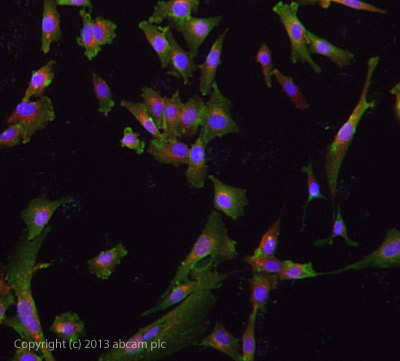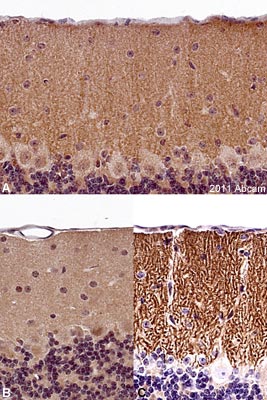
ICC/IF image of ab106979 stained SKNSH cells. The cells were 4% formaldehyde fixed (10 min) and then incubated in 1%BSA / 10% normal goat serum / 0.3M glycine in 0.1% PBS-Tween for 1h to permeabilise the cells and block non-specific protein-protein interactions. The cells were then incubated with the antibody ab106979 at 5µg/ml overnight at +4°C. The secondary antibody (green) was DyLight® 488 goat anti- rabbit (ab96899) IgG (H+L) used at a 1/250 dilution for 1h. Alexa Fluor® 594 WGA was used to label plasma membranes (red) at a 1/200 dilution for 1h. DAPI was used to stain the cell nuclei (blue) at a concentration of 1.43µM.

Anti-DAGLA antibody (ab106979) at 1/100 dilution + Mouse heart tissue lysate at 35 µg

Anti-DAGLA antibody (ab106979) at 1/100 dilution + NCI-H292 cell lysate at 35 µg

ab106979 staining mouse cerebellum sections by IHC-P. The tissue was fixed with formaldehyde and a heat mediated antigen retrival step was performed with citric acid pH 6. Blocking of the sample was done with 1%BSA for 10 minutes at 21°C, followed by staining with ab106979 at 1/200 in TBS/BSA/azide for 16h at 21°C. A biotinylated goat anti-rabbit polyclonal antibody at 1/200 was used as the secondary antibody.DAG L alpha is particularly enriched along the membranes of the secondary dendritic processes of the Purkinje cells, giving a characteristic, striking pattern of positivity.The characteristic pattern is seen on the upper image which shows a wt section stained with ab106979 and is not present in the DAG L alpha KO mouse cerebellum section stained with ab106979 (lower left image).See Abreview



